IN THE ESOTERIC CRAFT of bell-founding, the name of Bollée of Le Mans is one of great renown. Yet the Bollée whose technical skills in this sphere were probably most famous is almost certainly better known for his achievements in pioneering the self-propelled road vehicle, a field in which his two sons were at least his equal.
Arnedee Bollée senior was born in 1844; in 1867 he visited the Paris World Exhibition and saw for the first time the new Michaux velocipede and steam omnibuses. This inspired him to develop a 'fast private carriage' and, in 1871, he established a workshop within the family foundry.
L'Obeissante
In the short space of two years, he developed a machine of quite revolutionary design, which combined many features of vehicles produced nearly a century later. His steam carriage, L'Obeissante, broke completely with the traditions of horse vehicle design and railway engineering which had characterised earlier road vehicles. It had a 12-seater body panelled in metal with embossed 'quilted' patterning and the rivetted iron chassis swept up into arches above the iron-spoked wheels, the front pair being carried in independently-sprung forks.
Steering, by twin chains running over elliptical cams, was geometrically precise - in complete contrast to the centre-pivot cart
steering used on many Victorian steam carriages - and controlled from a central
steering wheel. Each rear wheel was driven by a separate V-twin engine, and the
steering could be aided by shutting off the steam supply to one engine or the other, allowing L'Obeissante to pivot about the stationary rear wheel.
Tests proved the vehicle so successful that the Minister of Public Works granted permission for its use over a specified area, provided that the district engineer was given three days' warning of the itinerary which would be followed. In 1875, Bollée drove his carriage to Paris, where it enjoyed a
succes d'estime, despite having broken 75 traffic laws on the journey.
La Mancelle
This general layout was followed by Bollée's next venture, two four-wheel-driven, four-wheel-steered, all-round independently-sprung tramcars with steam power assistance for clutch and steering. But neither L'Obeissante nor the trams proved commercially successful, and Bollée turned to a new layout for his next vehicle, La Mancelle of 1878. This was probably the first vehicle to have the engine at the front under a bonnet, driving the rear axle through a propeller shaft, bevel gears and side chains; it lacked only a gearbox to pre-date the Systerne Panhard invented in 1892 by Emile Levassor.
La Mancelle had independent suspension by transverse leaf springs, a layout that would not reappear until well into the petrol age. Bollée showed La Mancelle at the 1878 Paris World Exhibition. He received orders which encouraged him to appoint a concessionaire general, one M. Lecordier, and to establish a workshop outside the factory.
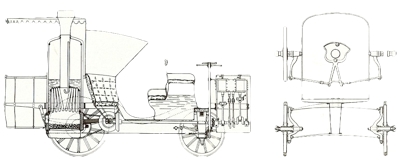
Side and plan views of Amédée Bollée Snr's La Mancelle or 1878. This was a six-seater steam carriage, available with either celecbe or postchaise bodywork, and was powered by a front- mounted, vertical-twin-cylinder engine-probably 'the first bonneted, tront-engined vehicle. The main feature, which was years ahead of its time" was the independent suspension.

L'Obeissante, built in 1873, was a 12 seater steam driven coach.
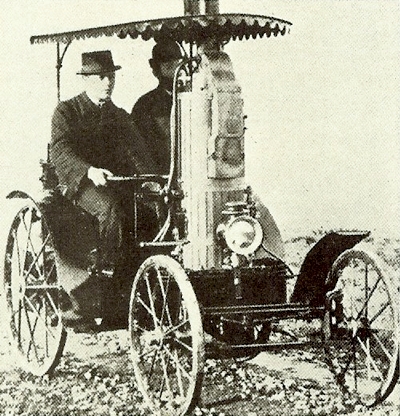
Amédée Bollée Jnr's first car was a 2 seater steamer, built in 1885.
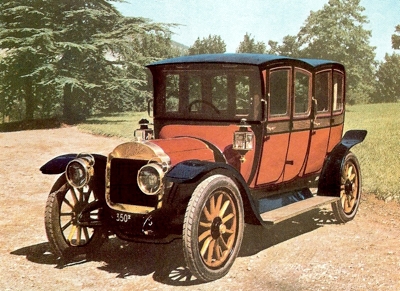
A Bollée Double Berline of 1911.

1910 Léon Bollée Landaulet 25/30 hp.
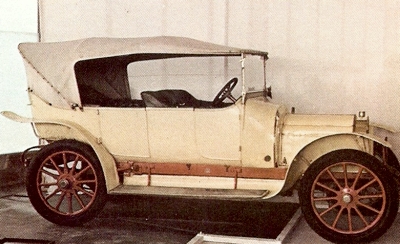
1912 Léon Bollée Torpedo.
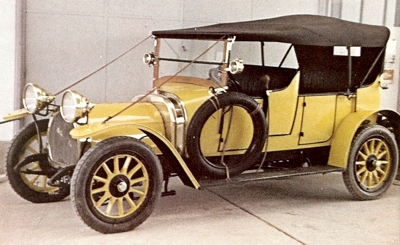
Amédée Bollée Jnr's last car was the Type-F, built from 1913 to 1919. He then turned to the manufacture of piston rings. |
Replicas of La Mancelle, with either caleche or postchaise bodywork, were offered and at least one was built; so, too, were two larger tractors built on the same lines but with the added feature of a power take-off which drove the wheels of the tender.
A rich Berlin banker named Barthold Aerons acquired the rights to produce the design in Germany. He had a grandiose plan to set up public bus services in Germany, Austria, Russia and Sweden, but the scheme was far too ambitious. Though twenty-two vehicles were built for Aerons in the Wohlert factory, in 1883 the company collapsed, the banker was ruined and Bollée received none of the royalty payments that had been due to him.
La Nouvelle
In 1880, Bollée built a new closed carriage, La Nouvelle, for his father; which many today consider to be the first saloon car ever, and was still capable of competing with honour in the Paris-Bordeaux-Paris race of 1895· But Amedee Bollée was losing interest in steam carriage production, which had cost him a small fortune, and he abandoned his ambition of producing a perfect road vehicle.
In 1881, how- ever, he built a remarkable six-seater, La Rapide, for his brother. Capable of 37 mph on solid iron tyres, this final model (of which two examples were produced) could be stoked and driven by one man.
La Rapide
From then on, Amedee Bollée devoted his life (he died in 1917) to bell-founding and when the Marquis de Brox asked him, in 1886, to build a steam carriage, he passed the commission over to his 18-year-old elder son, also called Amedee.
Amedee Bollée Jnr had already built for himself a light two-seater steamer of advanced concept. The vast machine he designed for the Marquis was a 16-seater 'double mail coach' which appeared as archaic as the two-seater was ahead of its time.
It was not until 1896 that Amedee Bollée Jnr's first successful petrol car appeared. This had a 2.3-litre, twin-cylinder engine, cast en bloc, mounted at the front of a metal chassis. Belt primary drive transmitted power to a Panhard-type gearbox, from which a transverse countershaft, incorporating a differential, drove each rear wheel through separate longitudinal propeller shafts with spiral bevel gearing at either end. This was the first time that spiral bevels had been used in a car transmission, but the arrangement was soon abandoned for side chains.
Le Torpilleurs
The car was built under licence by De Dietrich; an early modification was the fitting of an automatic spray carburettor of sophisticated design. Amedee Bollée jnr took part in a number of speed trials, as a result of which it became apparent to him that an attempt to reduce the air-resistance of the average motor car body was essential.
He secretly prepared four 8 hp racing cars, with
bodywork made entirely of aluminium, aggressively pointed at front and rear to give a smooth passage to the air; these torpilleurs, capable of a 'breakneck' 37 mph, were described by Express of Liege as 'fearsome but speedy'.
In the 1898 Paris-Amsterdam race, the four torpilleurs attracted much attention. Two of the cars, including that driven by Bollée jnr himself, were eliminated en route, but the others, driven by Gaudry and Loysel, were third and sixth. Gaudry might have been higher placed but for a 'bad spill' on the Etain road.
Vinet, though out of the race, concluded an excellent stroke of business by selling his car at Monter for the useful sum of 17 ,000 francs! Orders for touring versions of the new Bollée model poured in following the Paris-Amsterdam race.
The Bordeaux-Biarritz Race
De Dietrich booked orders exceeding one million francs within a few weeks. Towards the end of 1898, Loysel, driving his Paris-Amsterdam racer, won the Bordeaux-Biarritz race, while Thevin and Houry succeeded in driving Bollée-Dietrich tourers from Paris to St Petersburg and back.
Around the same time, the 'engineer-explorer', Taupeat de Saint-Syrneux, was the first auto-mobilist to reach the Niger, linking the valley of Senegal with Bamako, on a Bollée ; in 1899, he was the second motorist to reach Tananarive by car, and the first to make the journey without dismounting from his machine.
The 1350 Mile Tour de France
The most important speed event was the 1350-mile Tour de France organised by
Le Matin; for this race, Arnedee Bollée jnr designed three new torpilleurs with a precocious mechanical layout which included an incredible number of 'firsts'.
The cars had rear-mounted, 20 hp, four-cylinder engines cast
en bloc and fitted with twin carburettors, a boxed-up steel chassis, of unusual strength, independently suspended at the front (on double transverse springs) and underslung at the rear, twin track-rods and aluminium coachwork, which was not only smoothly streamlined above the chassis but also flat underneath to lessen air resistance.
There were, however, some archaic features - four-speed belt-drive, automatic inlet valves and hot-tube ignition. Hasty preparation spoiled the cars' chances, and road dust, sucked in by the carburettors, caused pre-ignition, which was a major factor in the team's withdrawal, though the cars showed themselves capable of 55 mph on the road. This fiasco marked Bollée's withdrawal from competition motoring. Henceforth, he was to concentrate on limited-production cars of great refinement.
One 1902 project had a twin-cylinder engine with a vibration damper consisting of a third
piston running counter to the others in an open-ended cylinder. In 1907, came the Type E, possibly the world's first ergonomically-designed motor car, priced at the same level as, and far more advanced in concept than a Rolls-Royce Silver Ghost. The mechanical refinement of this model was further enhanced by the adoption of another Bollée invention, hydraulic tappets.
Bollée Hosts The Wright Brothers
In 1908, Bollée played host to the Wright Brothers when they gave their first European displays of flying. The last production Arnedee Bollée car was the Type F of 1913; when the last of these had been assembled from pre-war spares in 1919, Bollée turned his attention to the manufacture of
piston rings, in which field his factory is still active. He died in 1926. His younger brother, Leon, born in 1870, invented a remarkable calculating machine, which was shown at the 1889 Paris Exhibition.
Until he was twenty-six he involved himself with the design of automatic machinery, then, early in 1896, he conceived a small, fast three-wheeler of somewhat basic design, remarkable mainly for the fact that it was the first vehicle to be sold with pneumatic
tyres as standard.
The elongated form of the tricycle, redolent of speed,' wrote Baudry de Saunier in 1896, 'gives it somewhat the semblance of a little torpedo-boat.' The machine was built under licence in France and England. English rights were acquired by the egregious Harry Lawson for £20,000 and a crude version of the machine, known as the Coventry Motette, was produced.
The Voiturette
Powered by its
air-cooled, single cylinder 650cc (3hp) engine and using hot-tube ignition and three forward gears, the Voiturette was at the time the fastest petrol-engined vehicle on the road. The vehicle had a tubular frame with a steel footwell at the front to protect passengers feet from puddles on the road, the driver sat at the rear.
However, the Bollée voiturette was only a short-lived venture. By 1899, Darracq were producing a new Leon Bollée, inspired partly by the voiturette layout. The Leon Bollee “Voiturette” first appeared in France in 1895. In 1899 the vehicle was superseded by a 4-wheeler vehicle and in 1901 the design rights were sold to Darracq. Even though the Leon Bollee name temporarily disappeared (re emerging in 1903 - 1933) the name “Voiturette” lived on.
After 1903, Leon Bollée turned to manufacture on his own account, building large conventional cars backed by Vanderbilt money; he died in 1913 and the subsequent products of his factory were indistinguishable from most other middle-class French cars of the 1920s. In 1924, the factory was acquired by William Morris, who produced mainly Wolseley-inspired models at Le Mans for seven years, until the Depression caused him to sell the works, which closed in 1933.



